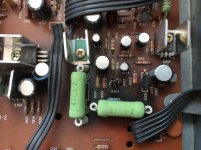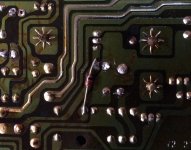I picked up a 7155 receiver and when powering up, the relay clicks in after a few seconds and there is a distinct low level hum from both speakers, with or without inputs connected. A little louder in the right channel. I think it is 120hz.
After about 10 minutes the hum diminishes to a point where I cannot hear it when 8 feet away from the speakers. I would like to fix it though.
I have a donor 7155 minus it’s volume/balance control.
I have a soldering iron and a DVM and access to the circuit diagram.
Any ideas where I should start looking, swapping etc to try and fix it?
I sounds really fine, detailed, warmish and all inputs work.
Thanks
Peter
After about 10 minutes the hum diminishes to a point where I cannot hear it when 8 feet away from the speakers. I would like to fix it though.
I have a donor 7155 minus it’s volume/balance control.
I have a soldering iron and a DVM and access to the circuit diagram.
Any ideas where I should start looking, swapping etc to try and fix it?
I sounds really fine, detailed, warmish and all inputs work.
Thanks
Peter
I’ve gained access to the amplifier board and find no swelling or leaking on any of the mentioned caps, but there is some scorching of the board in the vicinity of C907(photo attached). The center of the scorched area is at Q903.
I have a donor 7155 amp and the amp board looks very clean and no sign of overheating. The mentioned caps have been removed from the donor board ready to swap into the faulty one.
Should I address any further components in the overheated area?
Many thanks
Peter
I have a donor 7155 amp and the amp board looks very clean and no sign of overheating. The mentioned caps have been removed from the donor board ready to swap into the faulty one.
Should I address any further components in the overheated area?
Many thanks
Peter
Attachments
Swelling and leaking are only two of the visual clues.
Lack of this won't tell you what condition they are really in.
Don't use second hand parts to replace second hand parts.
Especially electrolytic's that come from the same age and model of unit.
If it's worn out in one, it will likely be worn out in the other.
That picture shows the bulk of the caps as heat stressed.
Shrunken sleeving.
What happens to an eletro when you subject it to prolonged high temperatures ?
As JonSnell said, hum will (normally) be result of failing main power supply filter caps.
It's far cheaper and easier to outright replace them rather than muck around removing, testing, reinstalling.
Spend the $50 on quality new caps.
Lack of this won't tell you what condition they are really in.
Don't use second hand parts to replace second hand parts.
Especially electrolytic's that come from the same age and model of unit.
If it's worn out in one, it will likely be worn out in the other.
That picture shows the bulk of the caps as heat stressed.
Shrunken sleeving.
What happens to an eletro when you subject it to prolonged high temperatures ?
As JonSnell said, hum will (normally) be result of failing main power supply filter caps.
It's far cheaper and easier to outright replace them rather than muck around removing, testing, reinstalling.
Spend the $50 on quality new caps.
Last edited:
Diode. Remove or not?
Just purchased a dozen caps from Mouser and included replacements for all the 9xx caps in the scorched area.
Apparently someone has soldered a diode across C917. Photo attached. I have no idea why, maybe it is a band aid for a problem? Is it related to a problematic cap that I am going to replace or something else?
The donor board that I have is very clean and all components intact.
Any help would be much appreciated.
Thanks
Peter
Just purchased a dozen caps from Mouser and included replacements for all the 9xx caps in the scorched area.
Apparently someone has soldered a diode across C917. Photo attached. I have no idea why, maybe it is a band aid for a problem? Is it related to a problematic cap that I am going to replace or something else?
The donor board that I have is very clean and all components intact.
Any help would be much appreciated.
Thanks
Peter
Attachments
Diode. Remove or not?
Just purchased a dozen caps from Mouser and included replacements for all the 9xx caps in the scorched area.
Apparently someone has soldered a diode across C917. Photo attached. I have no idea why, maybe it is a band aid for a problem? Is it related to a problematic cap that I am going to replace or something else?
The donor board that I have is very clean and all components intact.
Any help would be much appreciated.
Thanks
Peter
Just purchased a dozen caps from Mouser and included replacements for all the 9xx caps in the scorched area.
Apparently someone has soldered a diode across C917. Photo attached. I have no idea why, maybe it is a band aid for a problem? Is it related to a problematic cap that I am going to replace or something else?
The donor board that I have is very clean and all components intact.
Any help would be much appreciated.
Thanks
Peter
Could be a running change from the factory.
Then there's it being a nad.
The schematics do not always match the unit on the bench.
For some models there may be 3 or more different schematics for the same model.
Personally I'd leave it as is and just replace the caps.
Don't forget to go over the whole board for bad joints.
Another thing nad (and others) are known for.
Oh, and be gentle and careful with the soldering.
Tracks lifting can be fun to repair....
Then there's it being a nad.
The schematics do not always match the unit on the bench.
For some models there may be 3 or more different schematics for the same model.
Personally I'd leave it as is and just replace the caps.
Don't forget to go over the whole board for bad joints.
Another thing nad (and others) are known for.
Oh, and be gentle and careful with the soldering.
Tracks lifting can be fun to repair....
Thanks for your help.
The identical donor amp does not have the diode, and my knowledge of why it would be there is nonexistent. Or how it affects the circuit.
I’ve been scrutinizing for dry joints.
The hum I experience is quite minor when the amp has been on for a few minutes. I’d rather not have it, and if this doesn’t fix it, I will tolerate it. I bought it along with some Thiel speakers that I have fallen in love with, and when I first heard the system, didn’t even notice the noise. Otherwise, I like it.
Peter
The identical donor amp does not have the diode, and my knowledge of why it would be there is nonexistent. Or how it affects the circuit.
I’ve been scrutinizing for dry joints.
The hum I experience is quite minor when the amp has been on for a few minutes. I’d rather not have it, and if this doesn’t fix it, I will tolerate it. I bought it along with some Thiel speakers that I have fallen in love with, and when I first heard the system, didn’t even notice the noise. Otherwise, I like it.
Peter
This device is what ? 30 years old roughly ?
Schematics would only have been done in paper format.
So someone would have had to sit down and scan it.
The scan is at the mercy of the original paper, scanner bed and glass, the person that scanned it etc and so on.
If it worked as it was before starting the caps.
Then it should work far better after the caps.
Unless your going to reverse engineer the thing, don't worry about the diode or other differences.
These changes just 'are'.
In short, stop over thinking it. It will drive you insane.
Schematics would only have been done in paper format.
So someone would have had to sit down and scan it.
The scan is at the mercy of the original paper, scanner bed and glass, the person that scanned it etc and so on.
If it worked as it was before starting the caps.
Then it should work far better after the caps.
Unless your going to reverse engineer the thing, don't worry about the diode or other differences.
These changes just 'are'.
In short, stop over thinking it. It will drive you insane.
The diode across C917 was added to remove the possibility that reverse voltage could, in certain circumstances, arrive on the input to the regulator next to it as the power supply rails collapse at switch off.
The electrolytics, dry out, (unusual to swell), they just go low capacity and high ESR.
The electrolytics, dry out, (unusual to swell), they just go low capacity and high ESR.
- Status
- This old topic is closed. If you want to reopen this topic, contact a moderator using the "Report Post" button.
- Home
- Amplifiers
- Solid State
- NAD 7155 Hum

